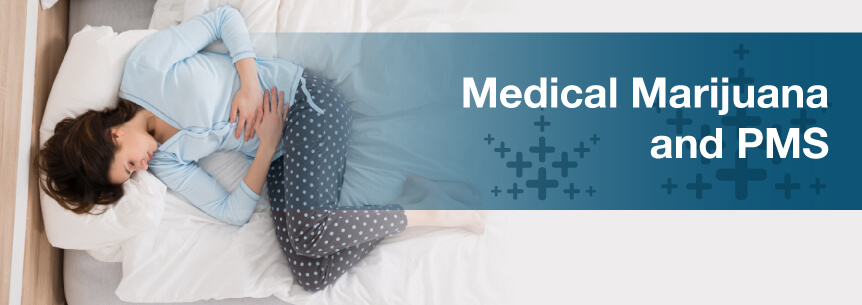
Women today will, on average, experience around 450 “periods” or menstrual cycles during her life. For those who suffer from period cramps and other premenstrual symptoms, this is a huge number — and it can feel like a whole lot more. Premenstrual syndrome (PMS) can cause much more than pain for women — it can drain them both physically and emotionally, which can be hard to cope with.
If you’re a woman, you know the agony of period cramps. You probably also know about the accompanying headaches and mood swings. While some women can get away with eating a chocolate bar and slapping on a heating pad for relief, others need something a bit stronger. A popular choice these days is medical marijuana for PMS. It’s not only a powerful painkiller, but it also helps smooth out your mood and brighten a bumpy day.
Premenstrual Dysphoric Disorder (PMDD) is a severe form of PMS. The symptoms begin about two weeks before a womans menses begins. And during that period, pain from cramps, headaches, and significant mood disorders are common. Irritability and depression are very intensive for about 6% of women who suffer from PMDD.
Unfortunately, cramps are a huge and common part of having a menstrual period. Cramping can be painful and occur in the first few days leading up to your period. They usually persist throughout your period. Cramping is a result of hormones triggering uterus muscle contractions.
Research shows the main psychoactive cannabinoid in medical cannabis for PMS, tetrahydrocannabinol (THC), works as a muscle relaxant. Apply cannabis topically via a transdermal patch or a cannabis-infused cream to find relief.
Cannabis’s chemical compounds release cannabinoid receptors to engage with your brain’s natural endocannabinoids. That’s why patients regularly use cannabis products to relieve depression, anxiety, stress and pain.
Find A Doctor Find A Dispensary
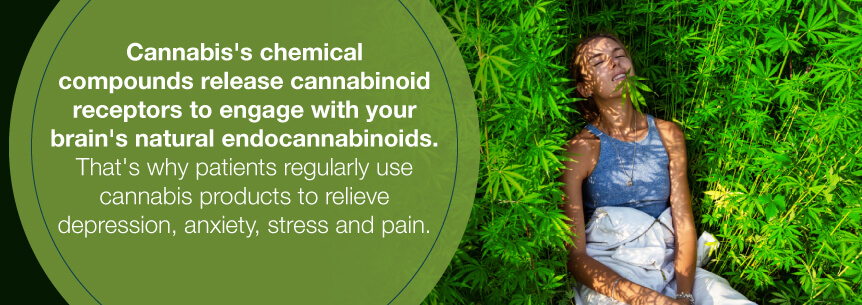
Many women use marijuana for PMS as an alternative to anti-depressant, prescription pain relievers and sleep aids.
Medical marijuana has not been shown to aid in restoring normal hormone levels. Therefore, it probably cannot treat the most often hypothesized cause of premenstrual syndrome. Nonetheless, it may treat some of the symptoms and is well known to be able to treat others, such as headaches.
Medical marijuana is a known treatment for headaches. It has been shown to help treatment-resistant migraines and cluster headaches, which are among the most painful headaches a person can experience. There are some theories that medical marijuana affects parts of the brain responsible for causing headaches. However, it is also known to have limited pain relief benefits as well. Research indicates medical marijuana may work well in conjunction with other pain relievers to both increase pain relief and decrease dosages of potentially dangerous pain medications.
As mentioned above, medical marijuana has known pain relief benefits to both help other medications and work as a mild pain reliever itself. Premenstrual cramps and aches are typically not excruciating and respond well to over-the-counter medications like Tylenol. Therefore, the mild pain-relieving effects of medical marijuana may be sufficient to treat premenstrual syndrome pain.
It is important to note medical marijuana — indeed all marijuana — may increase or cause symptoms of depression. This is well documented, though it is hard to say for sure given many depression sufferers self-medicate. It is difficult to see whether people who have or are predisposed to depression are more likely to use marijuana or need medical marijuana, or if marijuana causes the illness. Furthermore, some of the most prescribed medications for depression are known to increase depression and/or cause suicidal thoughts in some patients. This shows depression is difficult to treat with medication and some patients respond differently than others. In short, medication for depression helps some people and hurts others. Medical marijuana is no exception.
Interestingly, an online USC study found medical marijuana and even recreational marijuana do not have as many negative effects on depression as once thought. Roughly 4,400 people participated in the research that led to a paper by Dr. Mitch Earlywine and doctoral candidate Tom Denson. From the information provided by these individuals, the researchers concluded that marijuana users seemed to report fewer symptoms of depression than individuals who do not ingest marijuana in any form.
Evidence suggests marijuana has been used to treat insomnia since around the time humans figured out marijuana had medicinal properties. While it is unlikely to help people who are sleeping too much, sleepiness is a known side effect of marijuana, so it is likely to help people who respond positively to it fall asleep, fall back to sleep and stay asleep. Since not getting enough sleep can increase and even cause emotional and psychological symptoms, getting enough sleep can control other symptoms of premenstrual syndrome through allowing sufferers to get a good night’s sleep. As with all medical marijuana treatment, it should be done under the observation of a medical professional so all side effects and benefits can be monitored.
Try the following strains to relieve your PMS or PMDD symptoms:
You have a few options in the marijuana and PMS treatment method you use to effectively treat your PMS symptoms. These include:
Traditional Smoking
Many people simply smoke the flower for easy and fast relief. Smoking the herb provides you with more effective relief than applying it topically, and the experience will be less intense than that of an edible high. You experience immediate relief when smoking medical weed, so it’s easy to moderate how much or how little you need.
Topical Application
If you don’t like the “high” you experience from smoking, you can still find relief from your pain by applying medical pot topically via lotion or cream. Topicals allow you to pinpoint exactly where you want pain relief (e.g., your abdomen).
Teas and Edibles
When you’re not getting enough relief with topical applications, you can drink marijuana-infused tea or ingest a cannabis edible for effective pain relief. Remember, edibles do tend to bring on a stronger body-high experience, but often, this turns out to be the best option when you’re dealing with your most painful period day.
It’s never been easier to get started with your cannabis and PMS treatment plan. All you have to do is search for a medical marijuana dispensary or connect with a doctor through Marijuana Doctors. Have all your questions regarding medical weed answered by a specialist who will also guide you into scheduling an appointment with an accredited marijuana doctor in your area.
Find A Doctor Find A Dispensary
PMS refers to both the emotional and physical symptoms women experience before they begin their menstrual period after ovulation. Most researchers believe PMS occurs just days after you ovulate due to progesterone and estrogen levels starting to fall drastically if you’re not pregnant. Typically, symptoms of PMS tend to go away several days after you start your period once your hormone levels begin to rise again.
While some women will go through their menstrual cycle experiencing only mild symptoms or none at all, others will have severe symptoms that interfere with school, work and other everyday activities. If you’re experiencing severe PMS symptoms, it could indicate something worse than PMS — premenstrual dysphoric disorder (PMDD). If this is the case with you, you should definitely discuss it with your doctor.
Different imbalances cause five types of PMS. All are typically treatable with lifestyle and dietary changes and supplementation. The five PMS types include:
Approximately 80 percent of women experience Type A PMS characterized by:
A relative progesterone drop at the end of your cycle causes this type of PMS, which can make your menstrual period start suddenly or contain heavy clots.
With this type, you may experience cravings, typically for sweets or chocolate. You may have a drastic, even uncontrollable appetite increase. Around 60 percent of women have this type of PMS, and it’s usually related to abnormal blood sugar or insulin levels. You may experience:
Eating more frequently and adding a lot of protein to your diet may stabilize this excess insulin and therefore curb your cravings.
With Type D PMS, you may experience:
These symptoms are due to lower levels of estrogen and your “feel good” brain chemical, serotonin. Eating phytoestrogens like flaxseed and fennel and exercising may help reduce your symptoms. Type D is less common than the other types, occurring in about five percent of women.
If you have breast tenderness, swollen ankles and fingers, weight gain and bloating, you are likely experiencing water retention which comes with this type of PMS. Things like stress, high serotonin and impaired lymphatic flow can cause these issues. Avoid excess sodium and alcohol, and focus on eating more potassium-rich foods like avocados, broccoli and bananas to help reduce your symptoms. About 40 percent of women experience the Type H category of PMS.
Type P causes a lot of pain occurring in your:
An increase in inflammatory chemicals causes this symptom. Therefore, you should avoid nightshade vegetables, which make existing inflammation worse. These types of vegetables include:
Consume omega-3s since they’re rich in anti-inflammatory chemicals and may help reduce the severity of your pain over time.
For over 60 years, doctors and the general culture have acknowledged premenstrual phase symptoms of a menstrual cycle. But the concept of a clinical syndrome definition is only 40 years old.
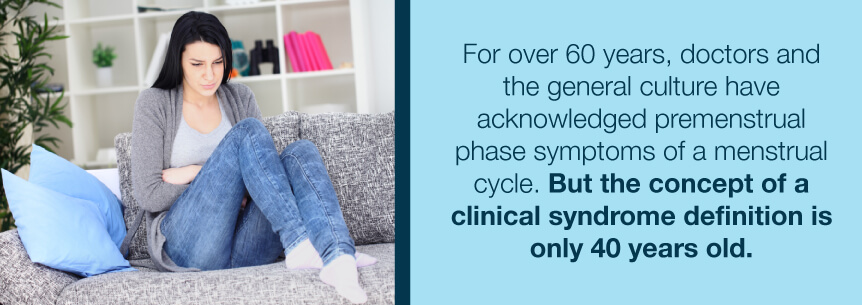
The symptoms women experience are mainly psychological with behavioral, emotional and somatic components. Doctors don’t know the cause of these symptoms. They have a varied prevalence across cultural groups, and they seem to have the same response to inactive placebos as they do to active preparations. There’s still no verifiable evidence on the basis of PMS, and the suggestion of the term “syndrome” for PMS still makes some researchers skeptical.
PMS makes women experience a wide range of symptoms, including:
Estimates show three of every four women menstruating experience some form of PMS.
While the recurrence of PMS symptoms is usually predictable, the emotional and physical changes you go through can vary from mild to intense. Thankfully, you can find lifestyle adjustments and treatments to help you manage or reduce your PMS symptoms.
There is a long list of potential symptoms you may have with PMS, but most women seem to experience only a few of the following:
Physical symptoms may include:
In some women, the emotional stress and physical pain are so intense that it impacts everyday living. But no matter how severe the symptoms are, they tend to go away within four days of the beginning of a menstrual period.
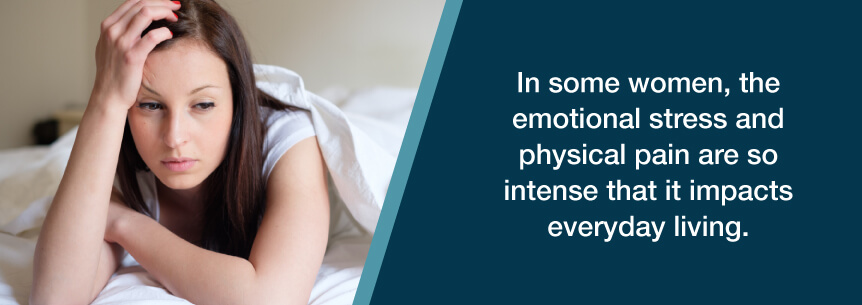
Some women experience PMS with disabling symptoms each month. These symptoms include:
When unrecognized and untreated, PMS can bring about complications causing your symptoms to worsen and make life more challenging. Some existing conditions can worsen during the premenstrual or menstrual phase of a woman’s cycle. Doctors refer to this phenomenon as menstrual magnification. Conditions may include:
During the premenstrual period, some women experience more frequent or severe asthma attacks.
Around 50 percent of women who experience migraines report a link with menstruation, generally in the first days before or after their menstruation begins. Menstrual migraines often last longer, are more severe and don’t have auras when compared to migraines occurring at other times during the month.
The premenstrual phase may exacerbate other chronic medical conditions, including:
Two potentially severe complications that often occur with untreated PMS symptoms include:
Two weeks before, during or in the days right before menstruation, women with PMS may experience severe symptoms of depression. When PMS is not recognized or treated, the symptoms of depression can cause you to feel as though you have something wrong with your mind since these low moods and depressive symptoms occur for no apparent reason. It may even be seriously debilitating and disrupt your enjoyment of life if left untreated.
Anxiety can be a debilitating PMS symptom manifesting as feelings of agitation, tension and general anxiety. Women with premenstrual syndrome often start experiencing a high level of anxiety during the two weeks before their menstruation that worsens in the days right before they begin their menstruation.
Anxiety symptoms of unrecognized and untreated PMS may make you feel you have something wrong with your mind since you’re so “on edge” and anxious for no good reason. Anxiety has the ability to disrupt your enjoyment of life just as much as depression does.
Statistics on PMS from Florida Hospital show:
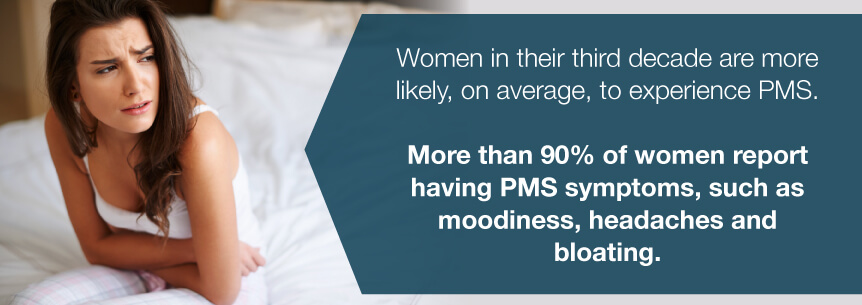
The Office on Women’s Health division of the U.S. Department of Health & Human Services reports:
There aren’t any specific laboratory tests or findings to provide a positive premenstrual syndrome diagnosis. Your physician may assign a certain symptom or symptoms to PMS if it consistently recurs in your predictable premenstrual pattern.
Your physician may ask you to record your symptoms in a diary or calendar for a minimum of two menstrual cycles to establish your premenstrual pattern. In this documentation, you’ll mark the first day you experience the symptoms during PMS and the day they go away. You’ll also record the day you begin your period and the day it ends.
Most women can relieve their symptoms with lifestyle changes. However, depending on how severe your symptoms are, your physician might prescribe medication for your PMS. The response to medication varies among women. Some common medications prescribed include:
You take NSAIDs when you first begin your period. NSAIDs like naproxen (Naprosyn, Aleve) or ibuprofen (Motrin IB, Advil) help with breast discomfort and cramping.
Antidepressants may include:
These help reduce mood symptoms. Women with PMDD or severe PMS are typically prescribed SSRIs as their first line of treatment. You take SSRIs daily. However, in some cases, your doctor may recommend you limit the use of antidepressants to the two weeks before you begin your menstruation.
Diuretics (water pills) can help your body eliminate extra fluid through your kidneys when limiting salt intake or exercising aren’t enough to reduce bloating, swelling or weight gain associated with PMS. One such diuretic to help alleviate your PMS symptoms is Spironolactone (Aldactone).
Your doctor may prescribe hormonal contraceptives to stop ovulation and help provide PMS symptom relief.
To ease PMS symptoms, some women use the following herbal supplements:
Researchers persist in learning about and searching for fresh ways to treat the symptoms of premenstrual syndrome, including through the use of clinical trials for PMS.
Making changes in how you exercise, eat and approach everyday life may sometimes help reduce or manage your PMS symptoms. Try these lifestyle changes:
Partake in a minimum of 30 minutes of cycling, swimming, brisk walking or other aerobic activity several days of the week. Exercising regularly may help alleviate certain PMS symptoms like a depressed mood or fatigue. It also improves your overall health.
Ways to modify your diet include:
Many women find placing a heating pad on their abdomens or soaking in a warm bath provides relief from their PMS symptoms.
Ways to reduce stress include:
Keep a journal of your symptoms for several months to identify the timing and triggers of your symptoms. By doing this, you can work closely with your doctor to come up with a strategy to intervene or lessen your symptoms.